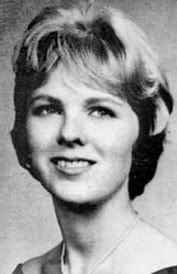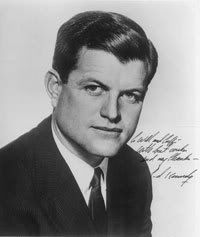On this day in 1969, following a party at Lawrence Cottage on Massachusetts'
Chappaquiddick Island,
Senator Ted Kennedy drove his mother's 1967
Oldsmobile Delmont 88 off the wooden Dike Bridge into tide-swept Poucha Pond; his passenger, 28 year-old
Mary Jo Kopechne, died. Exactly when she died as much as precisely how has given her story all the qualities of a legend - small comfort to the friends and family who may have lost their loved one to foul play, a crime (if indeed it was one) for which no responsibility has ever been taken.

Kopechne had been one of six so-called
Boiler-Room Girls, workers on
Robert F. Kennedy's ill-fated campaign for the Presidency in 1968; prior to this, she'd been RFK's secretary when he served in the US Senate. The other five -
Susan Tannenbaum, Maryellen Lyons,
Ann Lyons, Rosemary (Cricket) Keough, and
Esther Newberg - dubbed her 'the brightest' of their number. It was in their honour the party was held, following that day's
Edgartown Regatta, in which the Senator competed.
As there were six women at the party there were also six men - all married, and all without their wives: Kennedy,
Joe Gargan, US Attorney
Paul Markham, Charles Tretter, Raymond La Rosa, and John Crimmins.

Kennedy's own recollection was that he and Kopechne left the party at 11:15 PM in order to get her onto the last ferry of the night to
Martha's Vineyard at midnight; along the way, instead of turning onto the paved Chappaquiddick Road he instead turned onto the unpaved and unlit Dike Road (for some reason) where he soon drove onto the bridge, which had no guard rails. Subsequent forensic analysis has determined he was driving 35 miles per hour when the vehicle hit the water.
While he later described freeing himself, then trying to save her until he became exhausted, he left after some 20 minutes, passing several houses on his way back to Lawrence Cottage. Once there he gathered the men to return with him to the pond, although they later testified that the current had become too strong to attempt any rescue; the group then drove Kennedy to the ferry dock, whereupon he swam 500 feet across the channel and returned to his room at the Shiretown Inn in
Edgartown. At no time did any of them think to contact the authorities.
When around 8 AM the next morning two fisherman found the overturned car in the water and rushed to the nearest house to call the police they were the first people to do so; diver John Farrar was on the scene by 8:30 and at 8:45 Kopechne's lifeless body was being pulled from the water. It was Farrar's testimony that would later prove to be the most damning; according to him Kopechne's body had been frozen by
rigor mortis into such a position that would indicate she'd been breathing from a pocket of air trapped behind the back seat wheel well, and that her cause of death had been suffocation rather than drowning.
Had the police been called the previous night, in other words, Mary Jo Kopechne might still be alive today.
The senator's
subsequent statement in his own defense raised more questions than it offered answers; local police claimed to have seen Kennedy and Kopechne driving erratically around the island as late as 2:40 AM. As incriminating as this information is, it's the
least of the evidence to suggest that the true story of what happened that night has never been fully told.
While the
Chappaquiddick Incident may have prevented Ted Kennedy from running for the Presidency in 1972 and again in 1980, it didn't stop him from becoming an august statesman with the status of a demi-god in his home state. Did his own version of events, though, not only save him from jail but also help him to get away with murder?
*